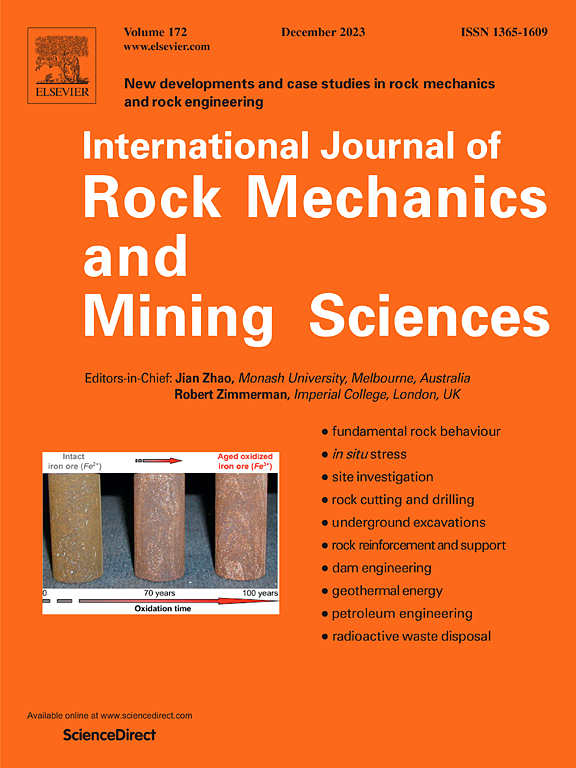应变岩爆自启动突变机理的室内试验研究
IF 7.5
1区 工程技术
Q1 ENGINEERING, GEOLOGICAL
International Journal of Rock Mechanics and Mining Sciences
Pub Date : 2025-06-21
DOI:10.1016/j.ijrmms.2025.106184
引用次数: 0
摘要
在岩爆的整个演化过程中,瞬时自启动的静动转变行为是推动岩石由静态变形向动态失稳转变的关键拐点。然而,该点的瞬态动力过程及其在触发岩爆中的作用尚不完全清楚。针对科学问题,本研究提出了一种基于岩石力学系统理论框架的物理模拟方法来再现自发岩爆。同时,开发了一种毫秒级分辨率的多源信息监测系统来捕捉瞬态动态行为。基于该方法,进行对照实验,解码瞬时静动转变过程,从力学和能量角度探讨自启动突变机制。在此基础上,对岩爆机理有了新的认识。结果表明:在过渡瞬间,冲击地压系统内围岩表现出自启动的弹性回弹动力行为,是触发冲击地压的关键;从力学上讲,这种行为直接对冲击岩石产生冲击载荷,是冲击岩爆的直接原因;在能量上,弹性回弹迫使围岩对冲击地压岩体进行瞬态做功,形成能量汇聚,缩短失稳所需时间,使冲击地压岩体内部有足够大的能量释放率,是冲击地压发生的内在原因。本文章由计算机程序翻译,如有差异,请以英文原文为准。
Study on the self-initiated catastrophe mechanism of strain rockburst: A laboratory experiment
Throughout the full evolution process of rockburst, the instantaneous self-initiated static-dynamic transition behavior represents a pivotal inflection point that propels rocks from static deformation to dynamic instability. Nevertheless, the transient dynamic process of this point and its role in triggering rockburst remain incompletely understood. Addressing the scientific issue, this study proposes a physical simulation methodology to reproduce self-initiated rockburst based on the theoretical framework of rock mechanics systems. Concurrently, a millisecond-resolution multi-source information monitoring system was developed to capture the transient dynamic behavior. Based on such method, controlled experiments were conducted to decode the instantaneous static-dynamic transition process, investigating the self-initiated catastrophe mechanism from mechanical and energy perspectives. Under the work, some new insights into rockburst mechanism are acquired. The results show that: during the transition instant, the surrounding rock within the rockburst system exhibits self-initiated elastic rebound dynamic behaviour that is the key to triggering rockburst. Mechanically, this behaviour directly generates immediate impact loading on the burst rock, performing as the direct cause of rockburst; Energetically, elastic rebound compels the surrounding rock to perform transient work on the burst rock, forming energy convergence and shortening the time required for instability, causing a sufficient large energy release rate within the burst rock, functioning as the inherent cause of rockburst.
求助全文
通过发布文献求助,成功后即可免费获取论文全文。
去求助
来源期刊
CiteScore
14.00
自引率
5.60%
发文量
196
审稿时长
18 weeks
期刊介绍:
The International Journal of Rock Mechanics and Mining Sciences focuses on original research, new developments, site measurements, and case studies within the fields of rock mechanics and rock engineering. Serving as an international platform, it showcases high-quality papers addressing rock mechanics and the application of its principles and techniques in mining and civil engineering projects situated on or within rock masses. These projects encompass a wide range, including slopes, open-pit mines, quarries, shafts, tunnels, caverns, underground mines, metro systems, dams, hydro-electric stations, geothermal energy, petroleum engineering, and radioactive waste disposal. The journal welcomes submissions on various topics, with particular interest in theoretical advancements, analytical and numerical methods, rock testing, site investigation, and case studies.

 求助内容:
求助内容: 应助结果提醒方式:
应助结果提醒方式:


